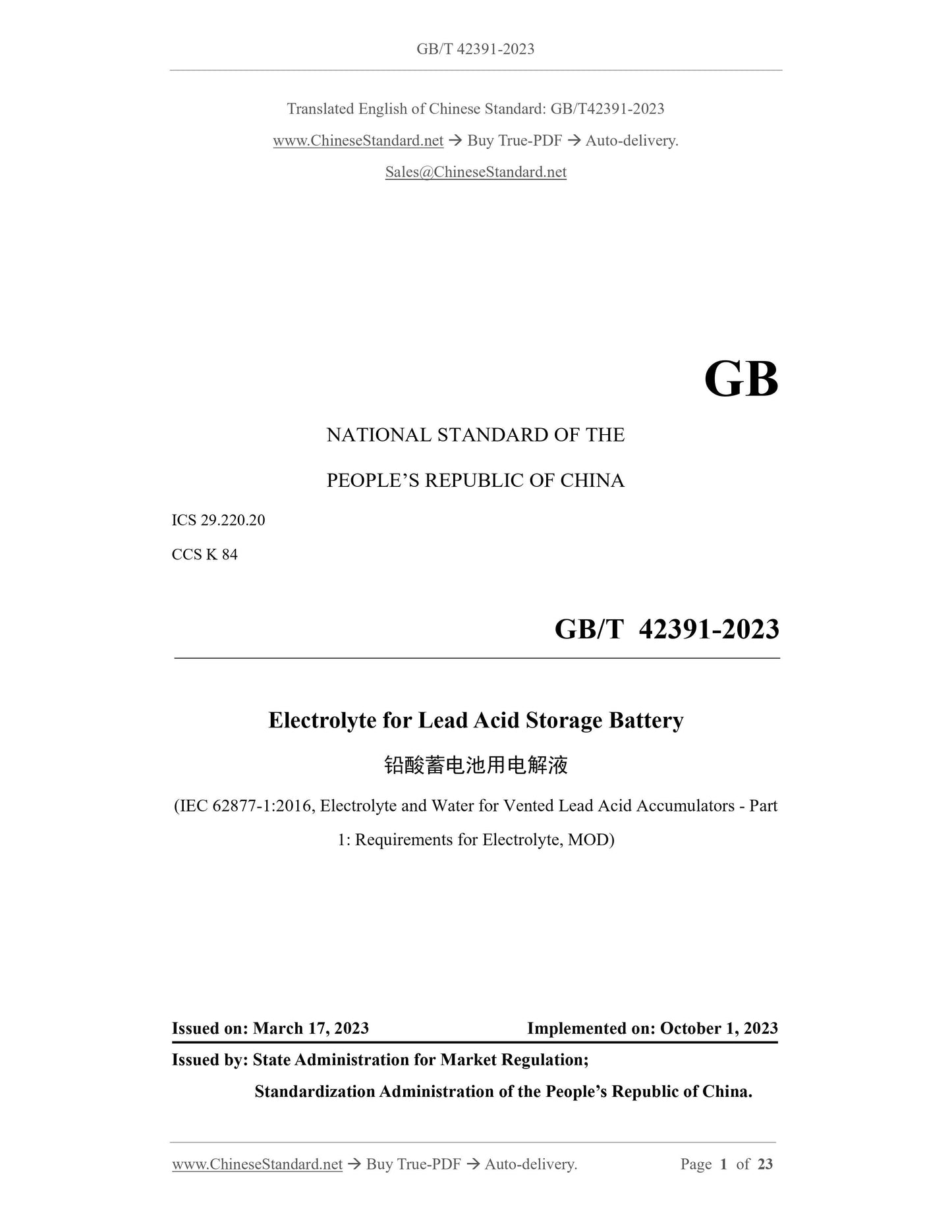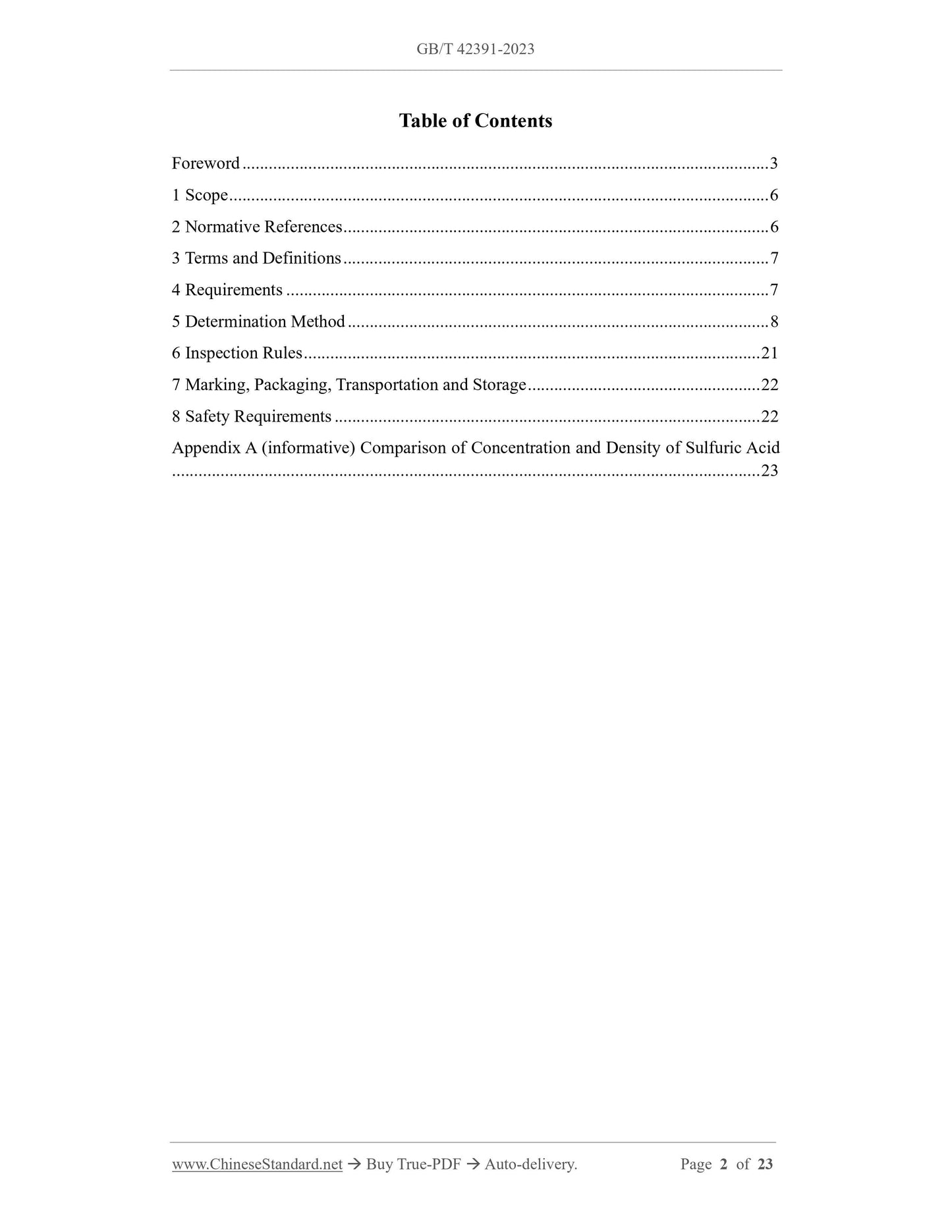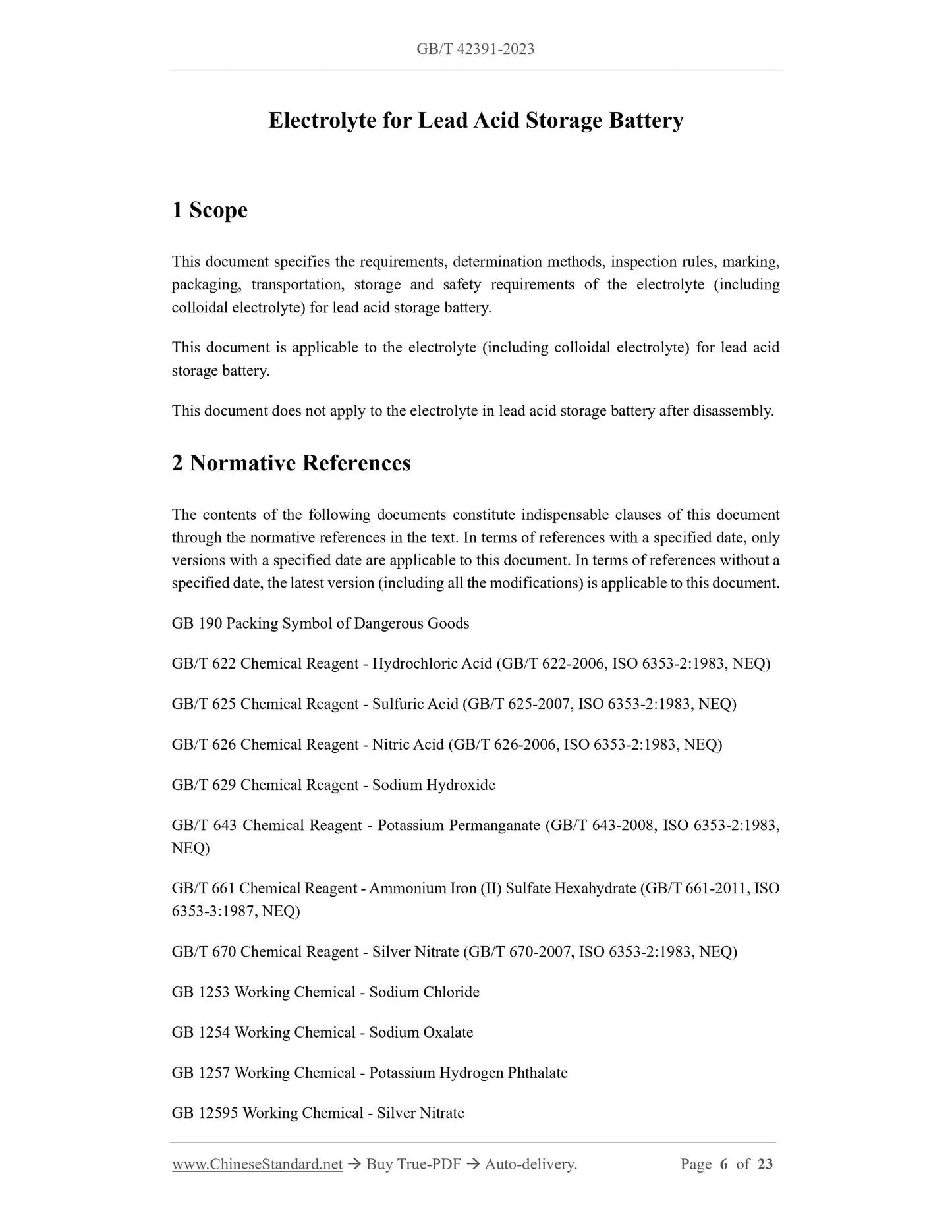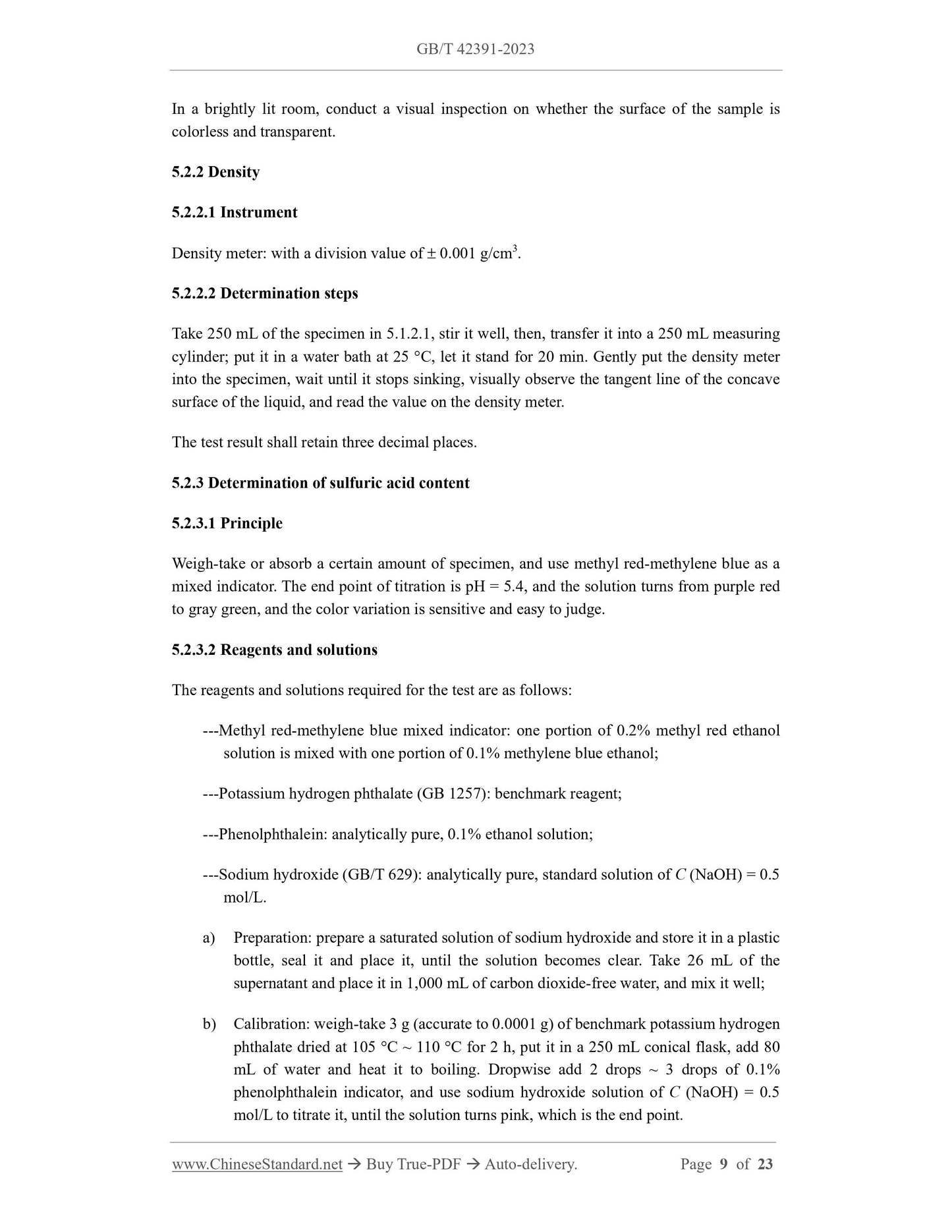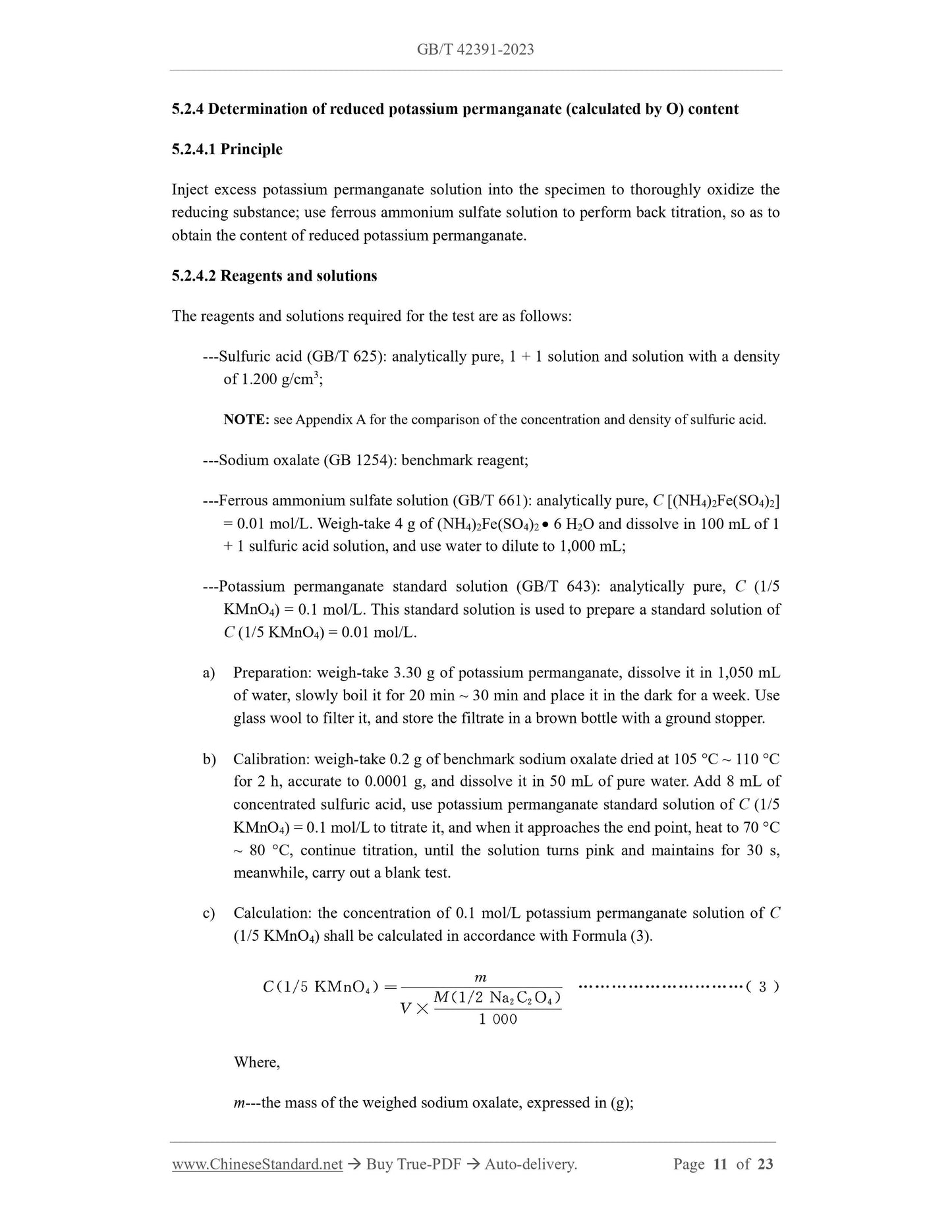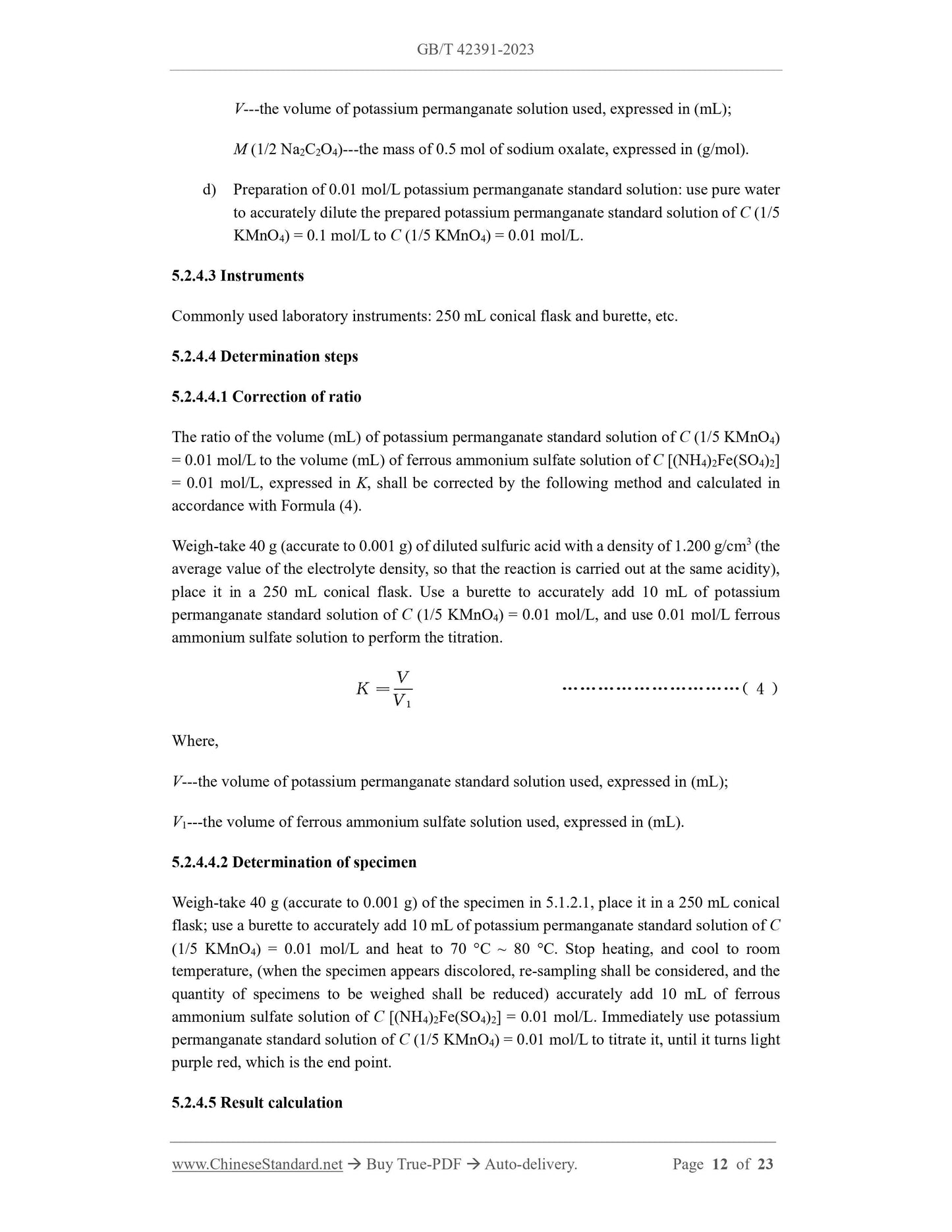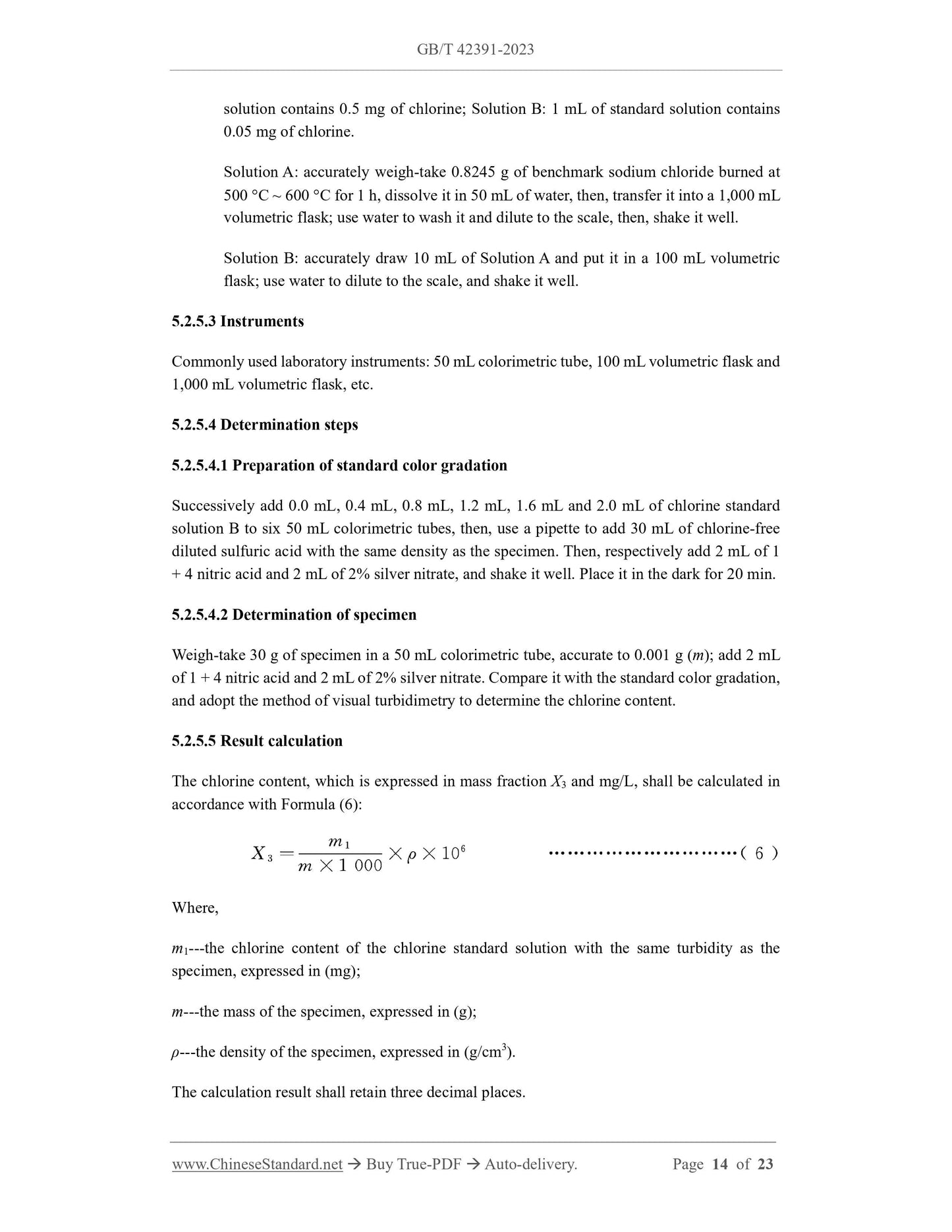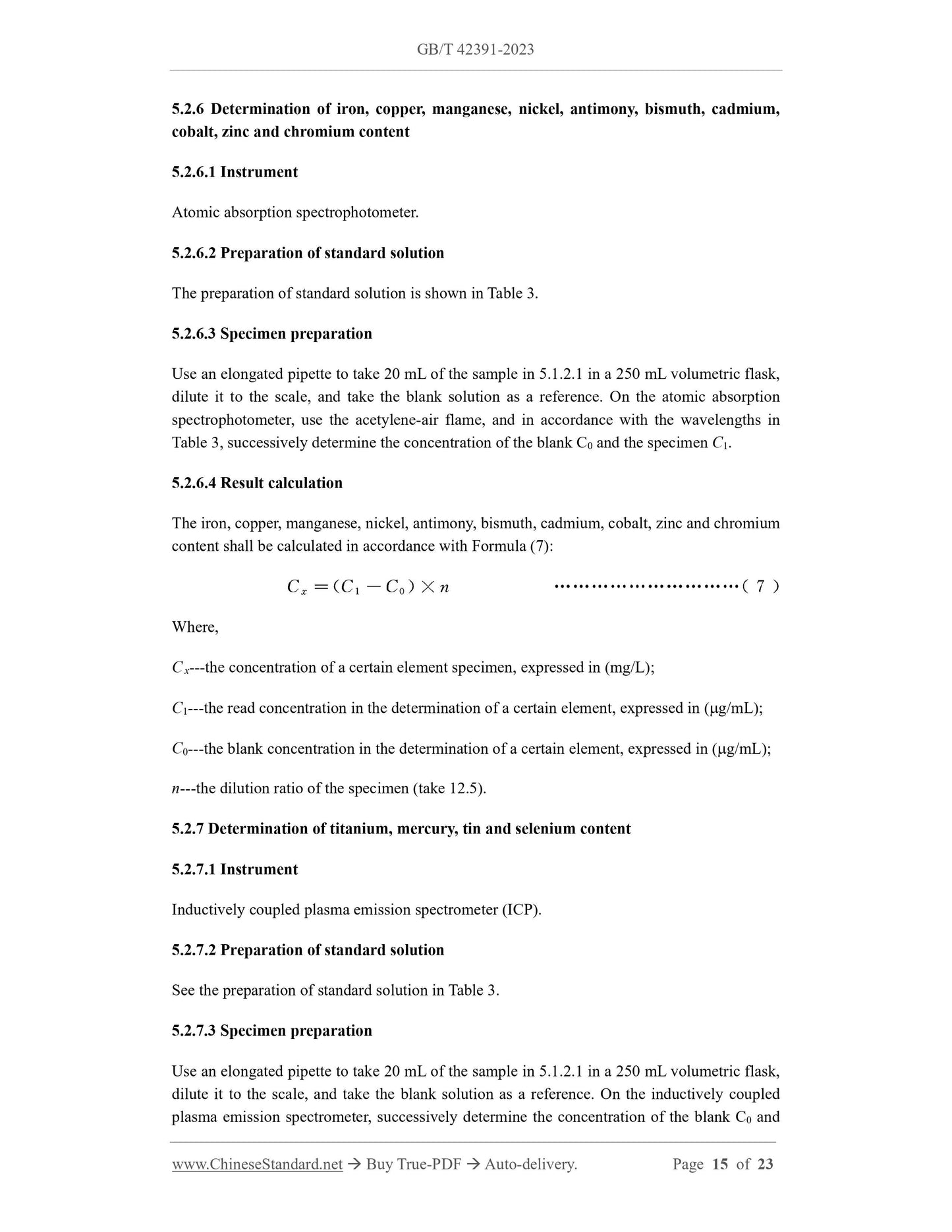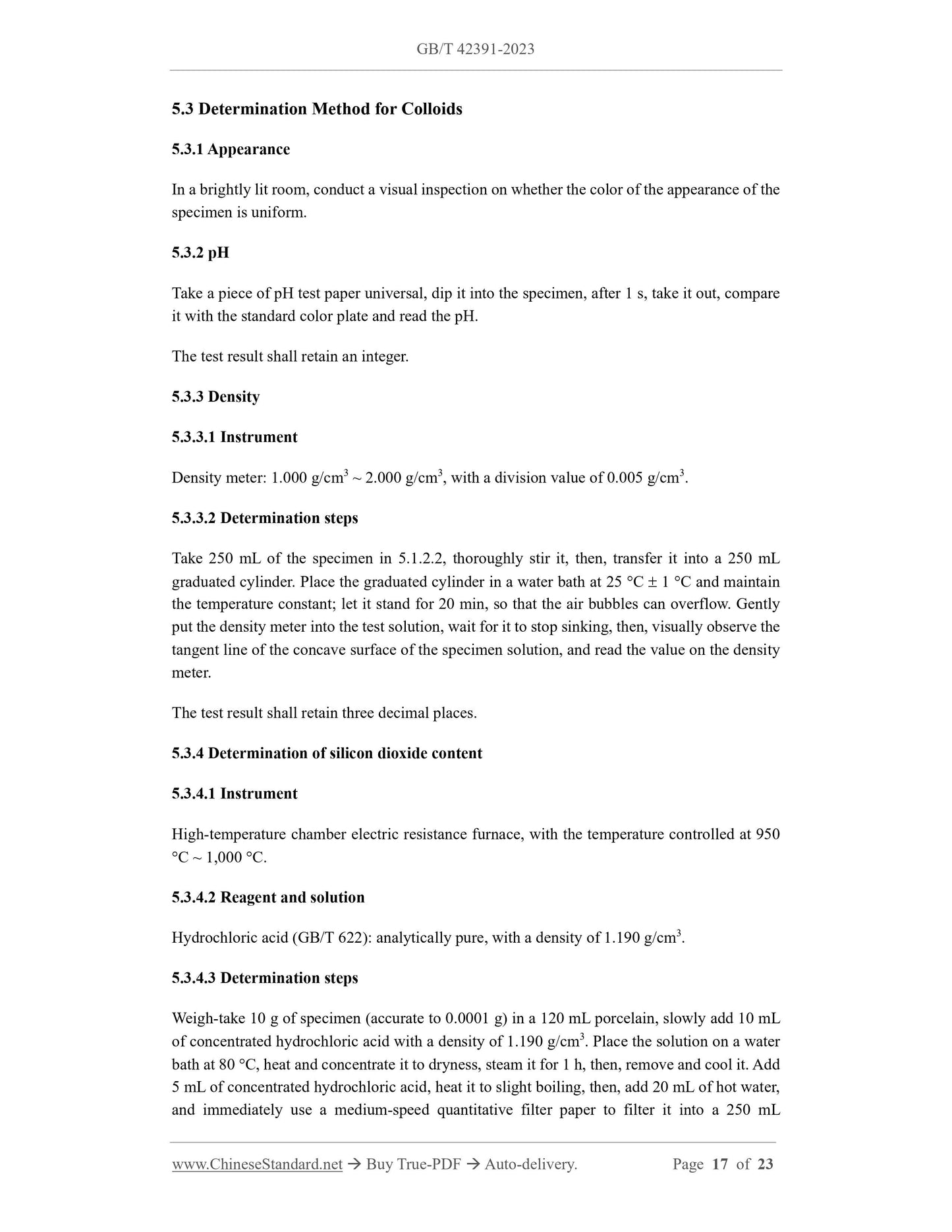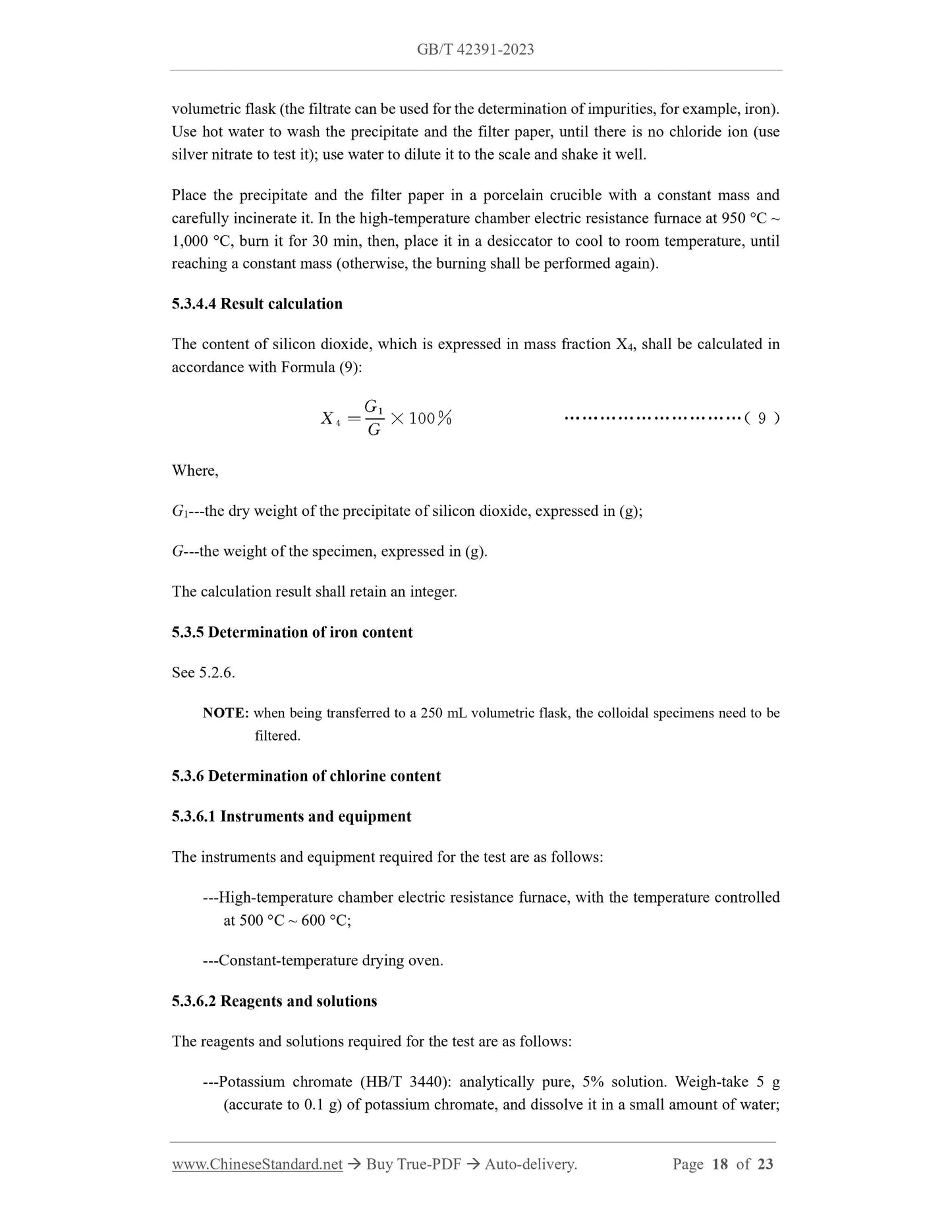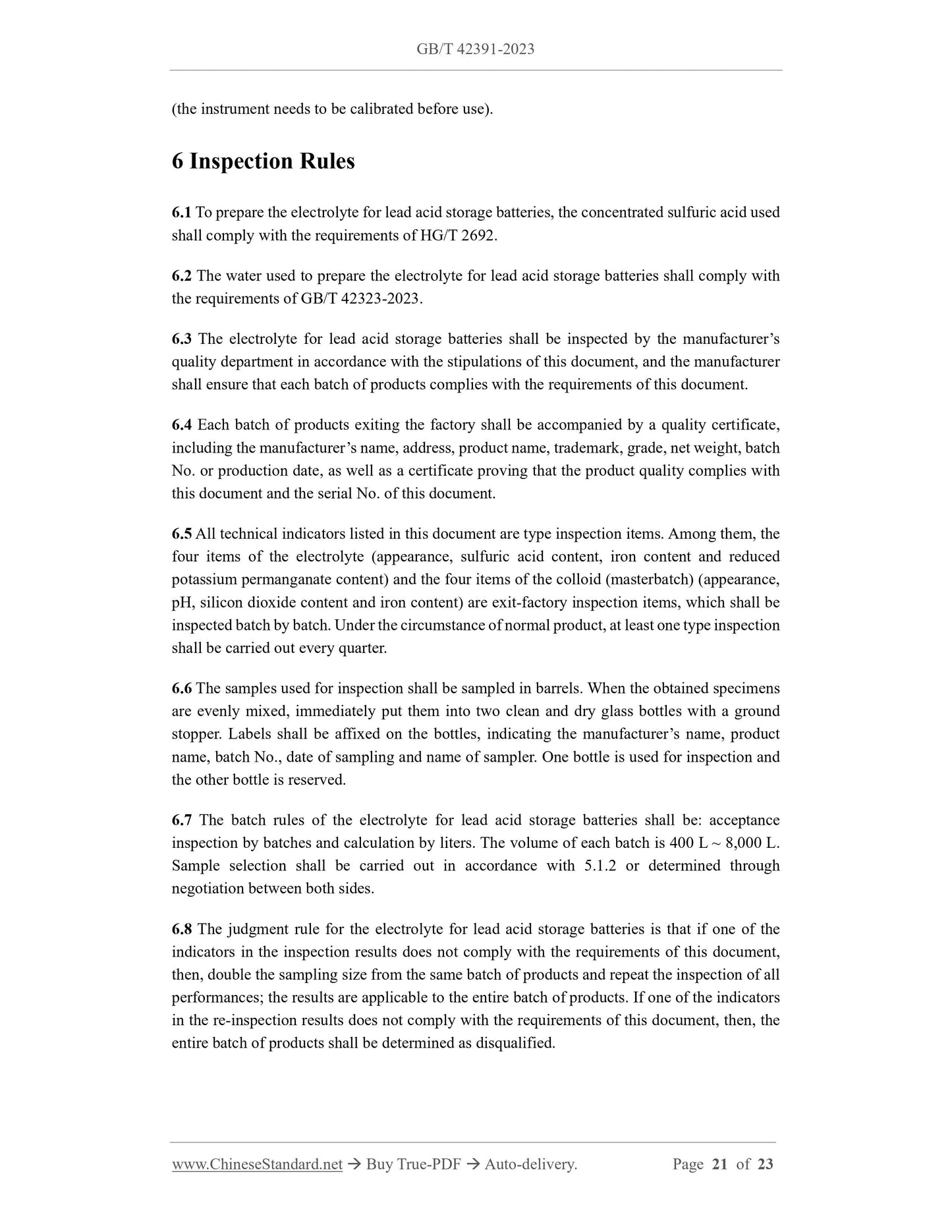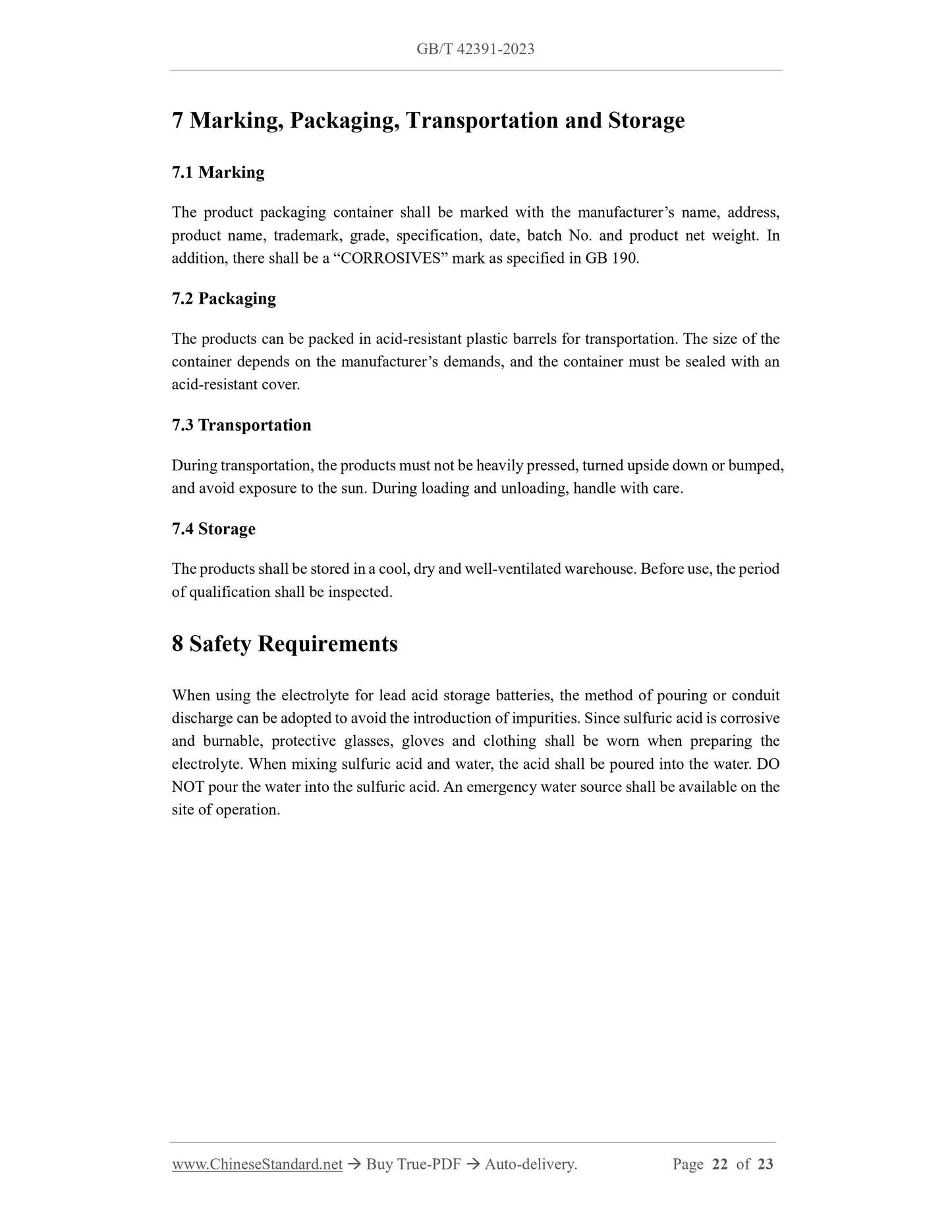1
/
of
12
www.ChineseStandard.us -- Field Test Asia Pte. Ltd.
GB/T 42391-2023 English PDF (GB/T42391-2023)
GB/T 42391-2023 English PDF (GB/T42391-2023)
Regular price
$260.00
Regular price
Sale price
$260.00
Unit price
/
per
Shipping calculated at checkout.
Couldn't load pickup availability
GB/T 42391-2023: Electrolyte for lead acid storage battery
Delivery: 9 seconds. Download (& Email) true-PDF + Invoice.
Get Quotation: Click GB/T 42391-2023 (Self-service in 1-minute)
Historical versions (Master-website): GB/T 42391-2023
Preview True-PDF (Reload/Scroll-down if blank)
GB/T 42391-2023
GB
NATIONAL STANDARD OF THE
PEOPLE’S REPUBLIC OF CHINA
ICS 29.220.20
CCS K 84
Electrolyte for Lead Acid Storage Battery
(IEC 62877-1:2016, Electrolyte and Water for Vented Lead Acid Accumulators - Part
1: Requirements for Electrolyte, MOD)
ISSUED ON: MARCH 17, 2023
IMPLEMENTED ON: OCTOBER 1, 2023
Issued by: State Administration for Market Regulation;
Standardization Administration of the People’s Republic of China.
Table of Contents
Foreword ... 3
1 Scope ... 6
2 Normative References ... 6
3 Terms and Definitions ... 7
4 Requirements ... 7
5 Determination Method ... 8
6 Inspection Rules ... 21
7 Marking, Packaging, Transportation and Storage ... 22
8 Safety Requirements ... 22
Appendix A (informative) Comparison of Concentration and Density of Sulfuric Acid
... 23
Electrolyte for Lead Acid Storage Battery
1 Scope
This document specifies the requirements, determination methods, inspection rules, marking,
packaging, transportation, storage and safety requirements of the electrolyte (including
colloidal electrolyte) for lead acid storage battery.
This document is applicable to the electrolyte (including colloidal electrolyte) for lead acid
storage battery.
This document does not apply to the electrolyte in lead acid storage battery after disassembly.
2 Normative References
The contents of the following documents constitute indispensable clauses of this document
through the normative references in the text. In terms of references with a specified date, only
versions with a specified date are applicable to this document. In terms of references without a
specified date, the latest version (including all the modifications) is applicable to this document.
GB 190 Packing Symbol of Dangerous Goods
GB/T 622 Chemical Reagent - Hydrochloric Acid (GB/T 622-2006, ISO 6353-2:1983, NEQ)
GB/T 625 Chemical Reagent - Sulfuric Acid (GB/T 625-2007, ISO 6353-2:1983, NEQ)
GB/T 626 Chemical Reagent - Nitric Acid (GB/T 626-2006, ISO 6353-2:1983, NEQ)
GB/T 629 Chemical Reagent - Sodium Hydroxide
GB/T 643 Chemical Reagent - Potassium Permanganate (GB/T 643-2008, ISO 6353-2:1983,
NEQ)
GB/T 661 Chemical Reagent - Ammonium Iron (II) Sulfate Hexahydrate (GB/T 661-2011, ISO
6353-3:1987, NEQ)
GB/T 670 Chemical Reagent - Silver Nitrate (GB/T 670-2007, ISO 6353-2:1983, NEQ)
GB 1253 Working Chemical - Sodium Chloride
GB 1254 Working Chemical - Sodium Oxalate
GB 1257 Working Chemical - Potassium Hydrogen Phthalate
GB 12595 Working Chemical - Silver Nitrate
In a brightly lit room, conduct a visual inspection on whether the surface of the sample is
colorless and transparent.
5.2.2 Density
5.2.2.1 Instrument
Density meter: with a division value of 0.001 g/cm3.
5.2.2.2 Determination steps
Take 250 mL of the specimen in 5.1.2.1, stir it well, then, transfer it into a 250 mL measuring
cylinder; put it in a water bath at 25 C, let it stand for 20 min. Gently put the density meter
into the specimen, wait until it stops sinking, visually observe the tangent line of the concave
surface of the liquid, and read the value on the density meter.
The test result shall retain three decimal places.
5.2.3 Determination of sulfuric acid content
5.2.3.1 Principle
Weigh-take or absorb a certain amount of specimen, and use methyl red-methylene blue as a
mixed indicator. The end point of titration is pH = 5.4, and the solution turns from purple red
to gray green, and the color variation is sensitive and easy to judge.
5.2.3.2 Reagents and solutions
The reagents and solutions required for the test are as follows:
---Methyl red-methylene blue mixed indicator: one portion of 0.2% methyl red ethanol
solution is mixed with one portion of 0.1% methylene blue ethanol;
---Potassium hydrogen phthalate (GB 1257): benchmark reagent;
---Phenolphthalein: analytically pure, 0.1% ethanol solution;
---Sodium hydroxide (GB/T 629): analytically pure, standard solution of C (NaOH) = 0.5
mol/L.
a) Preparation: prepare a saturated solution of sodium hydroxide and store it in a plastic
bottle, seal it and place it, until the solution becomes clear. Take 26 mL of the
supernatant and place it in 1,000 mL of carbon dioxide-free water, and mix it well;
b) Calibration: weigh-take 3 g (accurate to 0.0001 g) of benchmark potassium hydrogen
phthalate dried at 105 C ~ 110 C for 2 h, put it in a 250 mL conical flask, add 80
mL of water and heat it to boiling. Dropwise add 2 drops ~ 3 drops of 0.1%
phenolphthalein indicator, and use sodium hydroxide solution of C (NaOH) = 0.5
mol/L to titrate it, until the solution turns pink, which is the end point.
5.2.4 Determination of reduced potassium permanganate (calculated by O) content
5.2.4.1 Principle
Inject excess potassium permanganate solution into the specimen to thoroughly oxidize the
reducing substance; use ferrous ammonium sulfate solution to perform back titration, so as to
obtain the content of reduced potassium permanganate.
5.2.4.2 Reagents and solutions
The reagents and solutions required for the test are as follows:
---Sulfuric acid (GB/T 625): analytically pure, 1 + 1 solution and solution with a density
of 1.200 g/cm3;
NOTE: see Appendix A for the comparison of the concentration and density of sulfuric acid.
---Sodium oxalate (GB 1254): benchmark reagent;
---Ferrous ammonium sulfate solution (GB/T 661): analytically pure, C [(NH4)2Fe(SO4)2]
= 0.01 mol/L. Weigh-take 4 g of (NH4)2Fe(SO4)2 6 H2O and dissolve in 100 mL of 1
+ 1 sulfuric acid solution, and use water to dilute to 1,000 mL;
---Potassium permanganate standard solution (GB/T 643): analytically pure, C (1/5
KMnO4) = 0.1 mol/L. This standard solution is used to prepare a standard solution of
C (1/5 KMnO4) = 0.01 mol/L.
a) Preparation: weigh-take 3.30 g of potassium permanganate, dissolve it in 1,050 mL
of water, slowly boil it for 20 min ~ 30 min and place it in the dark for a week. Use
glass wool to filter it, and store the filtrate in a brown bottle with a ground stopper.
b) Calibration: weigh-take 0.2 g of benchmark sodium oxalate dried at 105 C ~ 110 C
for 2 h, accurate to 0.0001 g, and dissolve it in 50 mL of pure water. Add 8 mL of
concentrated sulfuric acid, use potassium permanganate standard solution of C (1/5
KMnO4) = 0.1 mol/L to titrate it, and when it approaches the end point, heat to 70 C
~ 80 C, continue titration, until the solution turns pink and maintains for 30 s,
meanwhile, carry out a blank test.
c) Calculation: the concentration of 0.1 mol/L potassium permanganate solution of C
(1/5 KMnO4) shall be calculated in accordance with Formula (3).
Where,
m---the mass of the weighed sodium oxalate, expressed in (g);
V---the volume of potassium permanganate solution used, expressed in (mL);
M (1/2 Na2C2O4)---the mass of 0.5 mol of sodium oxalate, expressed in (g/mol).
d) Preparation of 0.01 mol/L potassium permanganate standard solution: use pure water
to accurately dilute the prepared potassium permanganate standard solution of C (1/5
KMnO4) = 0.1 mol/L to C (1/5 KMnO4) = 0.01 mol/L.
5.2.4.3 Instruments
Commonly used laboratory instruments: 250 mL conical flask and burette, etc.
5.2.4.4 Determination steps
5.2.4.4.1 Correction of ratio
The ratio of the volume (mL) of potassium permanganate standard solution of C (1/5 KMnO4)
= 0.01 mol/L to the volume (mL) of ferrous ammonium sulfate solution of C [(NH4)2Fe(SO4)2]
= 0.01 mol/L, expressed in K, shall be corrected by the following method and calculated in
accordance with Formula (4).
Weigh-take 40 g (accurate to 0.001 g) of diluted sulfuric acid with a density of 1.200 g/cm3 (the
average value of the electrolyte density, so that the reaction is carried out at the same acidity),
place it in a 250 mL conical flask. Use a burette to accurately add 10 mL of potassium
permanganate standard solution of C (1/5 KMnO4) = 0.01 mol/L, and use 0.01 mol/L ferrous
ammonium sulfate solution to perform the titration.
Where,
V---the volume of potassium permanganate standard solution used, expressed in (mL);
V1---the volume of ferrous ammonium sulfate solution used, expressed in (mL).
5.2.4.4.2 Determination of specimen
Weigh-take 40 g (accurate to 0.001 g) of the specimen in 5.1.2.1, place it in a 250 mL conical
flask; use a burette to accurately add 10 mL of potassium permanganate standard solution of C
(1/5 KMnO4) = 0.01 mol/L and heat to 70 C ~ 80 C. Stop heating, and cool to room
temperature, (when the specimen appears discolored, re-sampling shall be considered, and the
quantity of specimens to be weighed shall be reduced) accurately add 10 mL of ferrous
ammonium sulfate solution of C [(NH4)2Fe(SO4)2] = 0.01 mol/L. Immediately use potassium
permanganate standard solution of C (1/5 KMnO4) = 0.01 mol/L to titrate it, until it turns light
purple red, which is the end point.
5.2.4.5 Result calculation
solution contains 0.5 mg of chlorine; Solution B: 1 mL of standard solution contains
0.05 mg of chlorine.
Solution A: accurately weigh-take 0.8245 g of benchmark sodium chloride burned at
500 C ~ 600 C for 1 h, dissolve it in 50 mL of water, then, transfer it into a 1,000 mL
volumetric flask; use water to wash it and dilute to the scale, then, shake it well.
Solution B: accurately draw 10 mL of Solution A and put it in a 100 mL volumetric
flask; use water to dilute to the scale, and shake it well.
5.2.5.3 Instruments
Commonly used laboratory instruments: 50 mL colorimetric tube, 100 mL volumetric flask and
1,000 mL volumetric flask, etc.
5.2.5.4 Determination steps
5.2.5.4.1 Preparation of standard color gradation
Successively add 0.0 mL, 0.4 mL, 0.8 mL, 1.2 mL, 1.6 mL and 2.0 mL of chlorine standard
solution B to six 50 mL colorimetric tubes, then, use a pipette to add 30 mL of chlorine-free
diluted sulfuric acid with the same density as the specimen. Then, respectively add 2 mL of 1
+ 4 nitric acid and 2 mL of 2% silver nitrate, and shake it well. Place it in the dark for 20 min.
5.2.5.4.2 Determination of specimen
Weigh-take 30 g of specimen in a 50 mL colorimetric tube, accurate to 0.001 g (m); add 2 mL
of 1 + 4 nitric acid and 2 mL of 2% silver nitrate. Compare it with the standard color gradation,
and adopt the method of visual turbidimetry to determine the chlorine content.
5.2.5.5 Result calculation
The chlorine content, which is expressed in mass fraction X3 and mg/L, shall be calculated in
accordance with Formula (6):
Where,
m1---the chlorine content of the chlorine standard solution with the same turbidity as the
specimen, expressed in (mg);
m---the mass of the specimen, expressed in (g);
ρ---the density of the specimen, expressed in (g/cm3).
The calculation result shall retain three decimal places.
5.2.6 Determination of iron, copper, manganese, nickel, antimony, bismuth, cadmium,
cobalt, zinc and chromium content
5.2.6.1 Instrument
Atomic absorption spectrophotometer.
5.2.6.2 Preparation of standard solution
The preparation of standard solution is shown in Table 3.
5.2.6.3 Specimen preparation
Use an elongated pipette to take 20 mL of the sample in 5.1.2.1 in a 250 mL volumetric flask,
dilute it to the scale, and take the blank solution as a reference. On the atomic absorption
spectrophotometer, use the acetylene-air flame, and in accordance with the wavelengths in
Table 3, successively determine the concentration of the blank C0 and the specimen C1.
5.2.6.4 Result calculation
The iron, copper, manganese, nickel, antimony, bismuth, cadmium, cobalt, zinc and chromium
content shall be calculated in accordance with Formula (7):
Where,
C x---the concentration of a certain element specimen, expressed in (mg/L);
C1---the read concentration in the determination of a certain element, expressed in (g/mL);
C0---the blank concentration in the determination of a certain element, expressed in (g/mL);
n---the dilution ratio of the specimen (take 12.5).
5.2.7 Determination of titanium, mercury, tin and selenium content
5.2.7.1 Instrument
Inductively coupled plasma emission spectrometer (ICP).
5.2.7.2 Preparation of standard solution
See the preparation of standard solution in Table 3.
5.2.7.3 Specimen preparation
Use an elongated pipette to take 20 mL of the sample in 5.1.2.1 in a 250 mL volumetric flask,
dilute it to the scale, and take the blank solution as a reference. On the inductively coupled
plasma emission spectrometer, successively determine the concentration of the blank C0 and
5.3 Determination Method for Colloids
5.3.1 Appearance
In a brightly lit room, conduct a visual inspection on whether the color of the appearance of the
specimen is uniform.
5.3.2 pH
Take a piece of pH test paper universal, dip it into the specimen, after 1 s, take it out, compare
it with the standard color plate and read the pH.
The test result shall retain an integer.
5.3.3 Density
5.3.3.1 Instrument
Density meter: 1.000 g/cm3 ~ 2.000 g/cm3, with a division value of 0.005 g/cm3.
5.3.3.2 Determination steps
Take 250 mL of the specimen in 5.1.2.2, thoroughly stir it, then, transfer it into a 250 mL
graduated cylinder. Place the graduated cylinder in a water bath at 25 C 1 C and maintain
the temperature constant; let it stand for 20 min, so that the air bubbles can overflow. Gently
put the density meter into the test solution, wait for it to stop sinking, then, visually observe the
tangent line of the concave surface of the specimen solution, and read the value on the density
meter.
The test result shall retain three decimal places.
5.3.4 Determination of silicon dioxide content
5.3.4.1 Instrument
High-temperature chamber electric resistance furnace, with the temperature controlled at 950
C ~ 1,000 C.
5.3.4.2 Reagent and solution
Hydrochloric acid (GB/T 622): analytically pure, with a density of 1.190 g/cm3.
5.3.4.3 Determination steps
Weigh-take 10 g of specimen (accurate to 0.0001 g) in a 120 mL porcelain, slowly add 10 mL
of concentrated hydrochloric acid with a density of 1.190 g/cm3. Place the soluti...
Delivery: 9 seconds. Download (& Email) true-PDF + Invoice.
Get Quotation: Click GB/T 42391-2023 (Self-service in 1-minute)
Historical versions (Master-website): GB/T 42391-2023
Preview True-PDF (Reload/Scroll-down if blank)
GB/T 42391-2023
GB
NATIONAL STANDARD OF THE
PEOPLE’S REPUBLIC OF CHINA
ICS 29.220.20
CCS K 84
Electrolyte for Lead Acid Storage Battery
(IEC 62877-1:2016, Electrolyte and Water for Vented Lead Acid Accumulators - Part
1: Requirements for Electrolyte, MOD)
ISSUED ON: MARCH 17, 2023
IMPLEMENTED ON: OCTOBER 1, 2023
Issued by: State Administration for Market Regulation;
Standardization Administration of the People’s Republic of China.
Table of Contents
Foreword ... 3
1 Scope ... 6
2 Normative References ... 6
3 Terms and Definitions ... 7
4 Requirements ... 7
5 Determination Method ... 8
6 Inspection Rules ... 21
7 Marking, Packaging, Transportation and Storage ... 22
8 Safety Requirements ... 22
Appendix A (informative) Comparison of Concentration and Density of Sulfuric Acid
... 23
Electrolyte for Lead Acid Storage Battery
1 Scope
This document specifies the requirements, determination methods, inspection rules, marking,
packaging, transportation, storage and safety requirements of the electrolyte (including
colloidal electrolyte) for lead acid storage battery.
This document is applicable to the electrolyte (including colloidal electrolyte) for lead acid
storage battery.
This document does not apply to the electrolyte in lead acid storage battery after disassembly.
2 Normative References
The contents of the following documents constitute indispensable clauses of this document
through the normative references in the text. In terms of references with a specified date, only
versions with a specified date are applicable to this document. In terms of references without a
specified date, the latest version (including all the modifications) is applicable to this document.
GB 190 Packing Symbol of Dangerous Goods
GB/T 622 Chemical Reagent - Hydrochloric Acid (GB/T 622-2006, ISO 6353-2:1983, NEQ)
GB/T 625 Chemical Reagent - Sulfuric Acid (GB/T 625-2007, ISO 6353-2:1983, NEQ)
GB/T 626 Chemical Reagent - Nitric Acid (GB/T 626-2006, ISO 6353-2:1983, NEQ)
GB/T 629 Chemical Reagent - Sodium Hydroxide
GB/T 643 Chemical Reagent - Potassium Permanganate (GB/T 643-2008, ISO 6353-2:1983,
NEQ)
GB/T 661 Chemical Reagent - Ammonium Iron (II) Sulfate Hexahydrate (GB/T 661-2011, ISO
6353-3:1987, NEQ)
GB/T 670 Chemical Reagent - Silver Nitrate (GB/T 670-2007, ISO 6353-2:1983, NEQ)
GB 1253 Working Chemical - Sodium Chloride
GB 1254 Working Chemical - Sodium Oxalate
GB 1257 Working Chemical - Potassium Hydrogen Phthalate
GB 12595 Working Chemical - Silver Nitrate
In a brightly lit room, conduct a visual inspection on whether the surface of the sample is
colorless and transparent.
5.2.2 Density
5.2.2.1 Instrument
Density meter: with a division value of 0.001 g/cm3.
5.2.2.2 Determination steps
Take 250 mL of the specimen in 5.1.2.1, stir it well, then, transfer it into a 250 mL measuring
cylinder; put it in a water bath at 25 C, let it stand for 20 min. Gently put the density meter
into the specimen, wait until it stops sinking, visually observe the tangent line of the concave
surface of the liquid, and read the value on the density meter.
The test result shall retain three decimal places.
5.2.3 Determination of sulfuric acid content
5.2.3.1 Principle
Weigh-take or absorb a certain amount of specimen, and use methyl red-methylene blue as a
mixed indicator. The end point of titration is pH = 5.4, and the solution turns from purple red
to gray green, and the color variation is sensitive and easy to judge.
5.2.3.2 Reagents and solutions
The reagents and solutions required for the test are as follows:
---Methyl red-methylene blue mixed indicator: one portion of 0.2% methyl red ethanol
solution is mixed with one portion of 0.1% methylene blue ethanol;
---Potassium hydrogen phthalate (GB 1257): benchmark reagent;
---Phenolphthalein: analytically pure, 0.1% ethanol solution;
---Sodium hydroxide (GB/T 629): analytically pure, standard solution of C (NaOH) = 0.5
mol/L.
a) Preparation: prepare a saturated solution of sodium hydroxide and store it in a plastic
bottle, seal it and place it, until the solution becomes clear. Take 26 mL of the
supernatant and place it in 1,000 mL of carbon dioxide-free water, and mix it well;
b) Calibration: weigh-take 3 g (accurate to 0.0001 g) of benchmark potassium hydrogen
phthalate dried at 105 C ~ 110 C for 2 h, put it in a 250 mL conical flask, add 80
mL of water and heat it to boiling. Dropwise add 2 drops ~ 3 drops of 0.1%
phenolphthalein indicator, and use sodium hydroxide solution of C (NaOH) = 0.5
mol/L to titrate it, until the solution turns pink, which is the end point.
5.2.4 Determination of reduced potassium permanganate (calculated by O) content
5.2.4.1 Principle
Inject excess potassium permanganate solution into the specimen to thoroughly oxidize the
reducing substance; use ferrous ammonium sulfate solution to perform back titration, so as to
obtain the content of reduced potassium permanganate.
5.2.4.2 Reagents and solutions
The reagents and solutions required for the test are as follows:
---Sulfuric acid (GB/T 625): analytically pure, 1 + 1 solution and solution with a density
of 1.200 g/cm3;
NOTE: see Appendix A for the comparison of the concentration and density of sulfuric acid.
---Sodium oxalate (GB 1254): benchmark reagent;
---Ferrous ammonium sulfate solution (GB/T 661): analytically pure, C [(NH4)2Fe(SO4)2]
= 0.01 mol/L. Weigh-take 4 g of (NH4)2Fe(SO4)2 6 H2O and dissolve in 100 mL of 1
+ 1 sulfuric acid solution, and use water to dilute to 1,000 mL;
---Potassium permanganate standard solution (GB/T 643): analytically pure, C (1/5
KMnO4) = 0.1 mol/L. This standard solution is used to prepare a standard solution of
C (1/5 KMnO4) = 0.01 mol/L.
a) Preparation: weigh-take 3.30 g of potassium permanganate, dissolve it in 1,050 mL
of water, slowly boil it for 20 min ~ 30 min and place it in the dark for a week. Use
glass wool to filter it, and store the filtrate in a brown bottle with a ground stopper.
b) Calibration: weigh-take 0.2 g of benchmark sodium oxalate dried at 105 C ~ 110 C
for 2 h, accurate to 0.0001 g, and dissolve it in 50 mL of pure water. Add 8 mL of
concentrated sulfuric acid, use potassium permanganate standard solution of C (1/5
KMnO4) = 0.1 mol/L to titrate it, and when it approaches the end point, heat to 70 C
~ 80 C, continue titration, until the solution turns pink and maintains for 30 s,
meanwhile, carry out a blank test.
c) Calculation: the concentration of 0.1 mol/L potassium permanganate solution of C
(1/5 KMnO4) shall be calculated in accordance with Formula (3).
Where,
m---the mass of the weighed sodium oxalate, expressed in (g);
V---the volume of potassium permanganate solution used, expressed in (mL);
M (1/2 Na2C2O4)---the mass of 0.5 mol of sodium oxalate, expressed in (g/mol).
d) Preparation of 0.01 mol/L potassium permanganate standard solution: use pure water
to accurately dilute the prepared potassium permanganate standard solution of C (1/5
KMnO4) = 0.1 mol/L to C (1/5 KMnO4) = 0.01 mol/L.
5.2.4.3 Instruments
Commonly used laboratory instruments: 250 mL conical flask and burette, etc.
5.2.4.4 Determination steps
5.2.4.4.1 Correction of ratio
The ratio of the volume (mL) of potassium permanganate standard solution of C (1/5 KMnO4)
= 0.01 mol/L to the volume (mL) of ferrous ammonium sulfate solution of C [(NH4)2Fe(SO4)2]
= 0.01 mol/L, expressed in K, shall be corrected by the following method and calculated in
accordance with Formula (4).
Weigh-take 40 g (accurate to 0.001 g) of diluted sulfuric acid with a density of 1.200 g/cm3 (the
average value of the electrolyte density, so that the reaction is carried out at the same acidity),
place it in a 250 mL conical flask. Use a burette to accurately add 10 mL of potassium
permanganate standard solution of C (1/5 KMnO4) = 0.01 mol/L, and use 0.01 mol/L ferrous
ammonium sulfate solution to perform the titration.
Where,
V---the volume of potassium permanganate standard solution used, expressed in (mL);
V1---the volume of ferrous ammonium sulfate solution used, expressed in (mL).
5.2.4.4.2 Determination of specimen
Weigh-take 40 g (accurate to 0.001 g) of the specimen in 5.1.2.1, place it in a 250 mL conical
flask; use a burette to accurately add 10 mL of potassium permanganate standard solution of C
(1/5 KMnO4) = 0.01 mol/L and heat to 70 C ~ 80 C. Stop heating, and cool to room
temperature, (when the specimen appears discolored, re-sampling shall be considered, and the
quantity of specimens to be weighed shall be reduced) accurately add 10 mL of ferrous
ammonium sulfate solution of C [(NH4)2Fe(SO4)2] = 0.01 mol/L. Immediately use potassium
permanganate standard solution of C (1/5 KMnO4) = 0.01 mol/L to titrate it, until it turns light
purple red, which is the end point.
5.2.4.5 Result calculation
solution contains 0.5 mg of chlorine; Solution B: 1 mL of standard solution contains
0.05 mg of chlorine.
Solution A: accurately weigh-take 0.8245 g of benchmark sodium chloride burned at
500 C ~ 600 C for 1 h, dissolve it in 50 mL of water, then, transfer it into a 1,000 mL
volumetric flask; use water to wash it and dilute to the scale, then, shake it well.
Solution B: accurately draw 10 mL of Solution A and put it in a 100 mL volumetric
flask; use water to dilute to the scale, and shake it well.
5.2.5.3 Instruments
Commonly used laboratory instruments: 50 mL colorimetric tube, 100 mL volumetric flask and
1,000 mL volumetric flask, etc.
5.2.5.4 Determination steps
5.2.5.4.1 Preparation of standard color gradation
Successively add 0.0 mL, 0.4 mL, 0.8 mL, 1.2 mL, 1.6 mL and 2.0 mL of chlorine standard
solution B to six 50 mL colorimetric tubes, then, use a pipette to add 30 mL of chlorine-free
diluted sulfuric acid with the same density as the specimen. Then, respectively add 2 mL of 1
+ 4 nitric acid and 2 mL of 2% silver nitrate, and shake it well. Place it in the dark for 20 min.
5.2.5.4.2 Determination of specimen
Weigh-take 30 g of specimen in a 50 mL colorimetric tube, accurate to 0.001 g (m); add 2 mL
of 1 + 4 nitric acid and 2 mL of 2% silver nitrate. Compare it with the standard color gradation,
and adopt the method of visual turbidimetry to determine the chlorine content.
5.2.5.5 Result calculation
The chlorine content, which is expressed in mass fraction X3 and mg/L, shall be calculated in
accordance with Formula (6):
Where,
m1---the chlorine content of the chlorine standard solution with the same turbidity as the
specimen, expressed in (mg);
m---the mass of the specimen, expressed in (g);
ρ---the density of the specimen, expressed in (g/cm3).
The calculation result shall retain three decimal places.
5.2.6 Determination of iron, copper, manganese, nickel, antimony, bismuth, cadmium,
cobalt, zinc and chromium content
5.2.6.1 Instrument
Atomic absorption spectrophotometer.
5.2.6.2 Preparation of standard solution
The preparation of standard solution is shown in Table 3.
5.2.6.3 Specimen preparation
Use an elongated pipette to take 20 mL of the sample in 5.1.2.1 in a 250 mL volumetric flask,
dilute it to the scale, and take the blank solution as a reference. On the atomic absorption
spectrophotometer, use the acetylene-air flame, and in accordance with the wavelengths in
Table 3, successively determine the concentration of the blank C0 and the specimen C1.
5.2.6.4 Result calculation
The iron, copper, manganese, nickel, antimony, bismuth, cadmium, cobalt, zinc and chromium
content shall be calculated in accordance with Formula (7):
Where,
C x---the concentration of a certain element specimen, expressed in (mg/L);
C1---the read concentration in the determination of a certain element, expressed in (g/mL);
C0---the blank concentration in the determination of a certain element, expressed in (g/mL);
n---the dilution ratio of the specimen (take 12.5).
5.2.7 Determination of titanium, mercury, tin and selenium content
5.2.7.1 Instrument
Inductively coupled plasma emission spectrometer (ICP).
5.2.7.2 Preparation of standard solution
See the preparation of standard solution in Table 3.
5.2.7.3 Specimen preparation
Use an elongated pipette to take 20 mL of the sample in 5.1.2.1 in a 250 mL volumetric flask,
dilute it to the scale, and take the blank solution as a reference. On the inductively coupled
plasma emission spectrometer, successively determine the concentration of the blank C0 and
5.3 Determination Method for Colloids
5.3.1 Appearance
In a brightly lit room, conduct a visual inspection on whether the color of the appearance of the
specimen is uniform.
5.3.2 pH
Take a piece of pH test paper universal, dip it into the specimen, after 1 s, take it out, compare
it with the standard color plate and read the pH.
The test result shall retain an integer.
5.3.3 Density
5.3.3.1 Instrument
Density meter: 1.000 g/cm3 ~ 2.000 g/cm3, with a division value of 0.005 g/cm3.
5.3.3.2 Determination steps
Take 250 mL of the specimen in 5.1.2.2, thoroughly stir it, then, transfer it into a 250 mL
graduated cylinder. Place the graduated cylinder in a water bath at 25 C 1 C and maintain
the temperature constant; let it stand for 20 min, so that the air bubbles can overflow. Gently
put the density meter into the test solution, wait for it to stop sinking, then, visually observe the
tangent line of the concave surface of the specimen solution, and read the value on the density
meter.
The test result shall retain three decimal places.
5.3.4 Determination of silicon dioxide content
5.3.4.1 Instrument
High-temperature chamber electric resistance furnace, with the temperature controlled at 950
C ~ 1,000 C.
5.3.4.2 Reagent and solution
Hydrochloric acid (GB/T 622): analytically pure, with a density of 1.190 g/cm3.
5.3.4.3 Determination steps
Weigh-take 10 g of specimen (accurate to 0.0001 g) in a 120 mL porcelain, slowly add 10 mL
of concentrated hydrochloric acid with a density of 1.190 g/cm3. Place the soluti...
Share
